STEREO TIMES: EX-M1

Fellow Stereo Times reviewer Terry London told me about an exciting new integrated amplifier from a company called Kinki Studio. He had it in for review, while he was still writing for Home Theater Review, and invited me to come by and check it out. Despite his infectious enthusiasm for the piece, I never did make it out to his home to give it a listen.
Fast forward six months, and Bernard Li, owner of Charisma Audio (the Canadian importer for Kinki Studio and many other great brands), asked if I would be interested in reviewing an integrated amplifier from Kinki Studio called the EX-M1. I said yes, of course! It didn't occur to me until I shared with a friend that I had an integrated amp coming in for review, that he reminded me that it was the same piece that Terry had invited me over to evaluate. Slowly, everything started to come into focus.
Technically Speaking
Not long after arranging the review with Bernard, the Kinki Studio EX-M1 (hence, the EX-M1) arrived, nicely packed, double boxed. There were two things that I took note of when trying to find out a little preliminary information on the EX-M1 before it arrived. First was the name "Kinki." What kind of name is that for a piece of audio gear? No wonder I never made it over to Terry's house to give it a listen. He routinely comes up with exotic equipment to review, anyway, so I'll just toss this one into that category. I have since come to learn that the name "Kinki" is the company owner and head designer wife's name. The owner himself just goes by the name "Liu." The other thing of note was the aesthetic of the EX-M1. There's a silver faceplate and two knobs. I'll call it stylish minimalism. I initially thought the EX-M1 was a small integrated like smaller digital pieces from Mytek and TEAC. So, imagine my surprise when moving the boxed EX-M1 downstairs to my listening room. I'm wondering what the heck is inside of the box. Surprisingly, the EX-M1 is a good-sized integrated amplifier that has some weight to it. It is no lightweight coming in at a net weight of 52.5 lbs. Those two control knobs are large but fit the aesthetic of the piece very well. The EX-M1 measures in at 17" W X 5" H X 14.75" D. The EX-M1 is solidly built, in fact, it's made as well as any piece you'd find from all but the most expensive high-end manufacturers and better than most similarly priced units. That comment refers to the EX-M1's build quality, internally as well as externally.
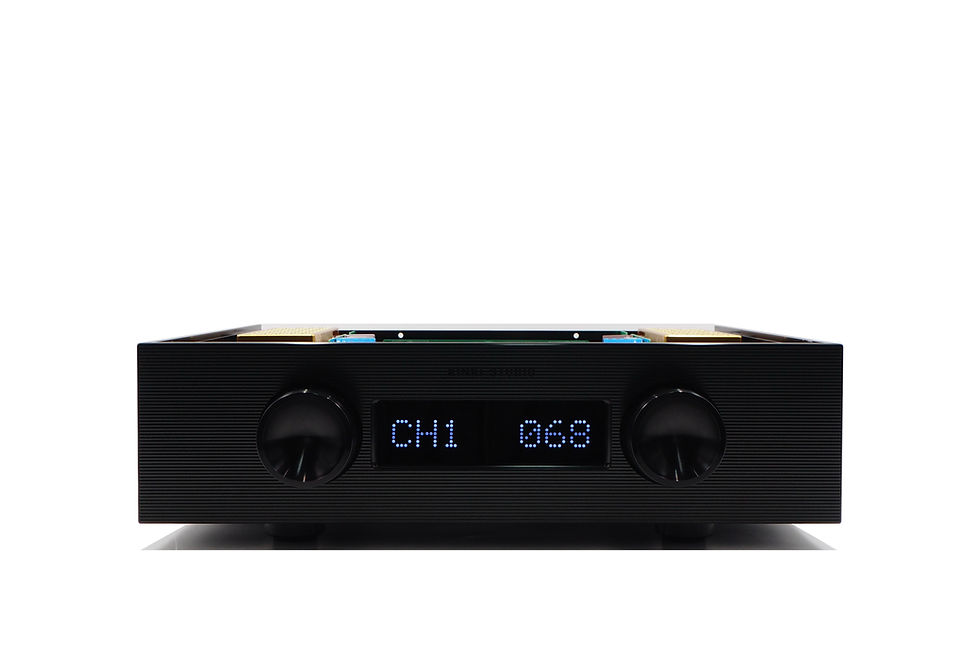
The case of the EX-M1 is made from anodized aluminum and seemingly has a nice smooth feel to it. Contrasting that, per Alvin at Kinki Studio, the designer utilizes a subtly ribbed faceplate that gives the unit an artistic finish. On that faceplate, Kinki Studio chose to go the minimalist route. As mentioned above, there are two large knobs on the faceplate and a large display. The knob on the left controls on/off and input selection functions while the knob on the right controls volume and mute functions. On the rear of the EX-M1, there are four inputs. Inputs 1 thru 3 are single-ended and input 4 uses XLRs. To the right of the single-ended input connectors is a small toggle switch that controls gain and low gain. More on this later in the review. The speaker connectors, which are sourced from an OEM manufacturer in Taiwan, are on either side of the rear panel.
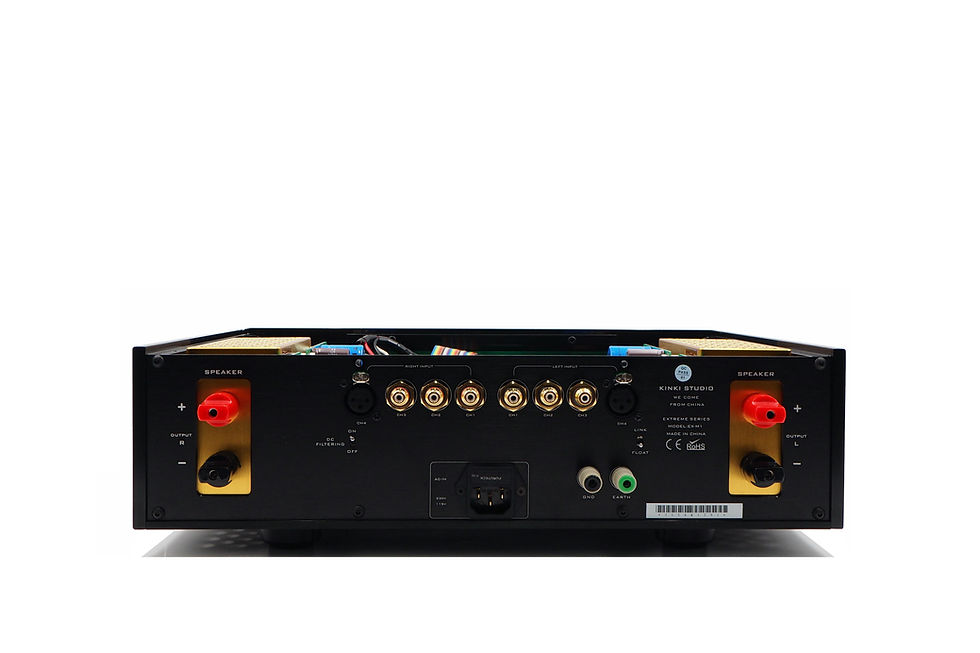
The IEC connector is located directly under the inputs. Per the Kinko Studio webpage, "Most amplifiers use a potentiometer for volume control. EX-M1 uses an advanced microprocessor-controlled, relay-based R2R steps attenuator. Ultra-precise 256 steps linear volume control allow you to fine-adjust the volume for late-night-listening. The EX-M1 uses extremely high cost 0.2µm gold-plated printed circuit board (PCB). From the perspective of PCBs, the designer is well aware of the limitations on the fine contact area of the general circuit board, specifically increasing the soldered area at each solder joint and adding as much shielding as possible. It uses two 300VA UK made AMPLIMO transformers, one each for Left and Right channel power supplies, so that the power does not interfere with each other to improve the channel separation."
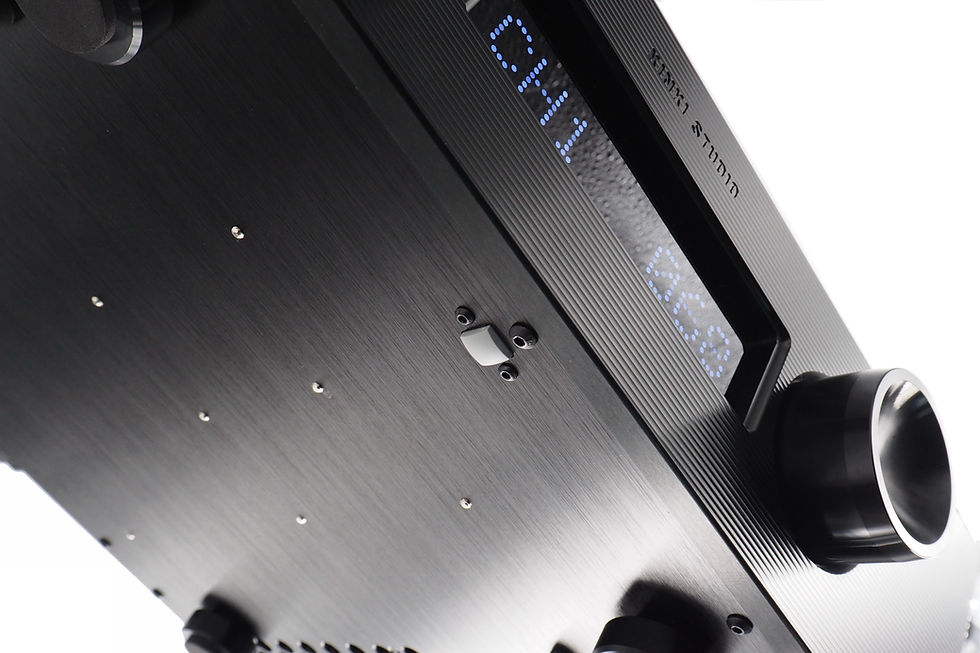
The EX-M1's display is large. My eyesight is not very good, but I could easily read the display of the EX-M1 from my listening seat about 14 feet away. You can also dim or turn the display off. The volume control is 256 steps, with each step being 0.5 dB. The EX-M1's remote control is highly useful and allows you to utilize its functionality from your seated position. You can also control POWER (on/Off) MUTE, LIGHTING (Dim/Brighten Display), CH+/CH- (Input Source Selection) V+/V- (Volume Control). The EX-M1 comes with a nicely laid out owner's manual, remote control and, a generic AC cord.
How It Sounds
I had my CD player set on repeat for three days before I began any serious listening. I did not expect the sound I was hearing from the EX-M1. I have heard audio equipment from out of China, with JE Audio being my clear favorite Chinese audio manufacturer. The EX-M1's sound is very engaging, exciting and natural. My initial thought was that I wondered if Bernard Li had sent me something other than a $2400 integrated amplifier because this sound far exceeds that. Tonality-wise, the EX-M1 is on the "slightly warm" side of the neutral camp, but only slightly. Its tonal colors are painted from a surprisingly large tonal palette. The EX-M1's top-end is extended and airy and has a lot of detail and musical information. There was no harshness or stridency whatsoever. For example, percussion kits sounded clean, distinct and very clear. Things like triangles, bells, and a bunch of other instruments we audiophiles love try to identify by reading the album liner notes, are reproduced with detail, speed, and the requisite amount of decay.
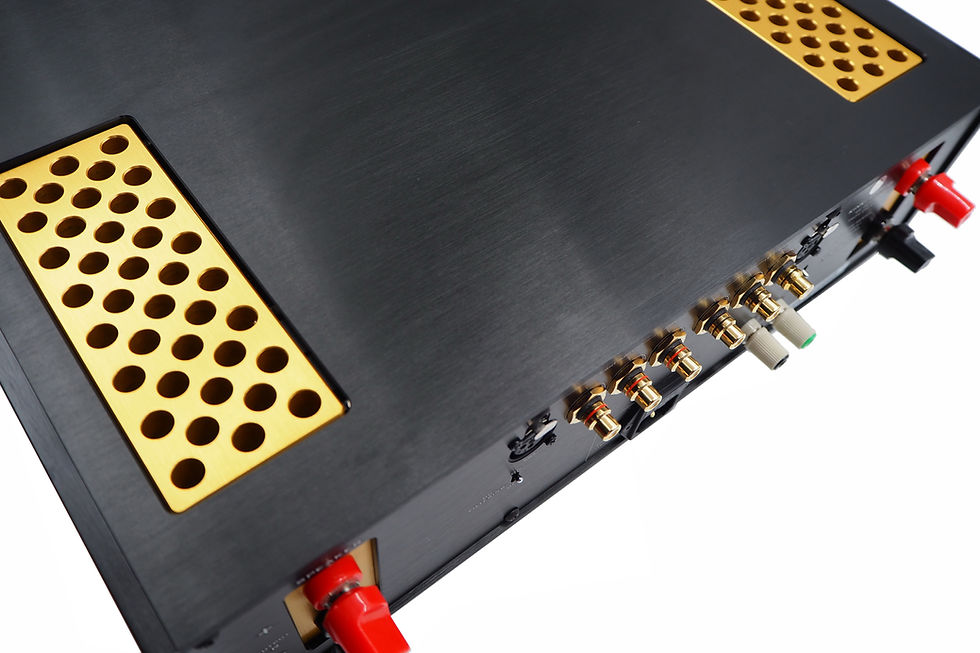
The EX-M1's performance reproducing transient response and inner detail is very good. The EX-M1 is very dynamic, especially when the music calls for it, but never gets aggressive. The midrange performance of the EX-M1 is good with a nice combination of bodily presence and nuanced timber, especially so with well-recorded performances. The EX-M1 possessed a deep and authoritative low-end and had a tight grip on each of my Tekton Moab's two 12" woofers. With the EX-M1 driving the Moab's, some techno-pop and classical recordings could excite rumblings in my listening room. The imaging performance of the EX-M1, was notable in my system in that it was average, with streaming music, to good, with CDs and vinyl. To be fair, though the stage width did not extend very much beyond the edges of my speakers, music never sounded cluttered or congested and there was a good amount of air between the performers on the stage. Here are some of my musical selections used for this review. For bass performance, I listened to "Bass Extremes: Cook Book" [Shrapnel Records, Inc.]. This collaboration of two wonderful bass players, Steve Bailey (Rock) and Victor Wooten (Funk and everything else) produced some of the best sounding bass collaborations, especially for two electric bassists. The EX-M1 allowed for a nice study in contrasts of the two bass players as Mr. Bailey performs with a fretless 6-string bass and Mr. Wooten's 4-stringer. The bass was tuneful, full and robust. Tracks like "Acoustic Brew" and "Cool Groove" were good examples of this. For dynamics, I used Dave Brubeck's Time Further Out [Columbia]. A lot of folks will listen to this album and swear it's a continuation of the famous quartet's popular album, Time Out. After becoming familiar with this album, I can see why people would say that. I think a deeper look at this album, and you'll see that the Dave Brubeck's band takes more chances with this album, like on tracks such as "Bluette" and "Blue Shadows in the Street." As for dynamics, tracks like "Far More Drums" and "Unsquare Dance", highlight the EX-M1's ability to portray music with speed, impacts and transient response, e.g., drumsticks popping on the drum rims.
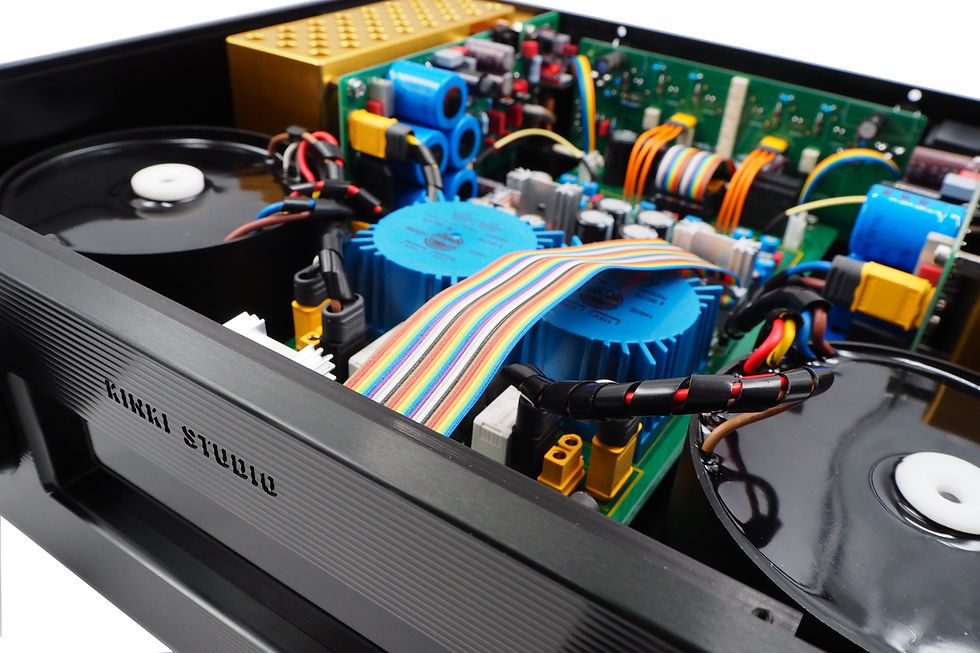
An excellent female vocal reference I find myself returning to is the recording of Sinne Eeg & Thomas Fonnesbaek's collaboration "Eeg-Fonnesbaek" [Stunt]. Ms. Eeg is a compelling vocalist that I've enjoyed listening to over the last few months. Her accompanist and bassist, Mr. Fonnesbaek, plays the upright on this recording. The EX-M1 did a marvelous job of portraying the feeling of closeness and intimacy you get from the microphone's perspective making this duo seem so eerily in your listening room. I felt that the fullness of tone to Sinne Eeg's voice and Thomas Fonnesbaek's detailed bass playing came across as more visceral and palpable. Especially on tracks like "Willow Weep for Me", "Taking it Slow," and "Body and Soul."
A Few More Thoughts
I must confess to being pleasantly surprised by the Kinki Studio EX-M1. It performed to a high level during the time it resided in my system. I did a lot of cable swapping during this review period and there were no hums, no loose connections, no unwanted pops or any unpleasantness. The EX-M1 is a set and forget product. Other than the times I tested the gain changes from the rear of the EX-M1, all of its functionality could be addressed at my seated position via the remote. With most of my listening being done with a top-notch VAC rig, or with BSC m100 mono-amps and a Klyne or Electron Images Amati preamp, I set a pretty high bar for a lot of different pieces of gear. The EX-M1 was not intimidated and didn't have to be embarrassed by its performance in my system. The EX-M1 fit right in with the other electronics in my system. I never came away wishing the review would be over so I could get back to enjoying my own system once again. I used the tape output of my Klyne SK-5A directly into the EX-M1 and listened to vinyl, which was a plus.
One of the other features that I appreciated about the EX-M1 is the flexibility of its volume control. Most preamps or integrated amplifiers have the regular volume output that you can control as you would typically, turning the volume up or down. Some have a little bit of a volume or gain boost where you can get a step or two more dB of gain to benefit those systems that could use a bit more output. The EX-M1 handles this a little differently with a "Low Gain" (-4 dB) switch. This is engaged by flipping the Gain/Low Gain switch to the down position on the back panel of the integrated. In this position, you adjust the volume control so that it takes, for example, ten clicks instead of five to reach the same volume. I found that this allowed me to have a finer sense of component matching. Sonically, I loved the volume operating in this mode because there was seemingly another level of detail retrieval to be realized. I also discovered I could play particularly loud, which I like to do on occasion. Still, the sound remained clean and under control no matter how loud I played music. The only downfall to listening to the volume control with all of these extra steps is that if you do a lot of late-night listening as I do while the wife's asleep - if she awakens, it takes a little bit longer to get the volume back down to where you want to be. Other than that, the volume control on the EX-M1 was purely a joy to use.
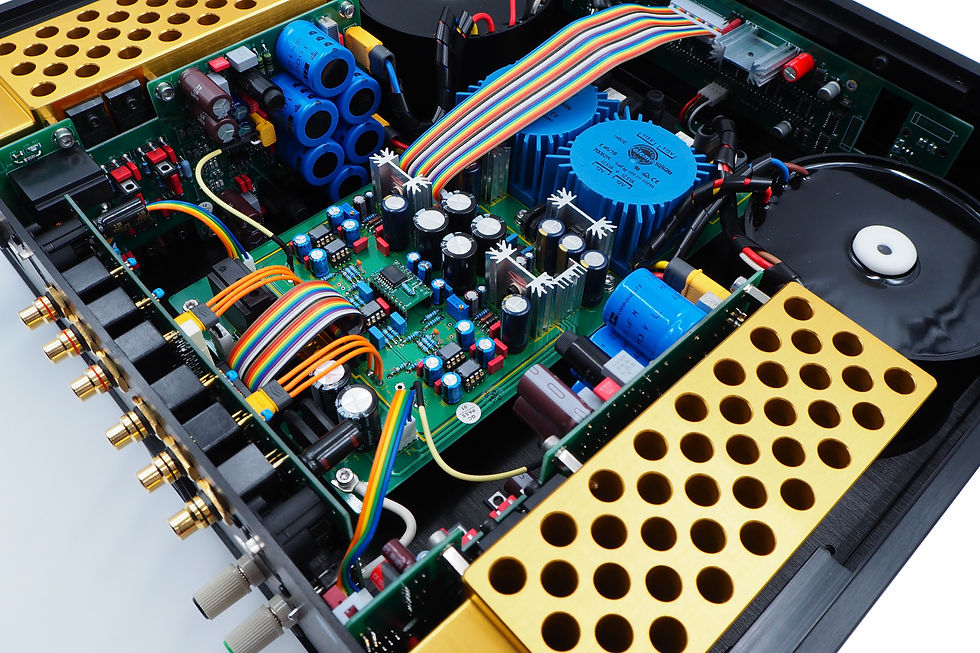
In terms of how it compares with other integrated amplifiers, I have some thoughts. I have heard the T+A PA 3000 HV integrated amp in friends' systems, and I have spent time with the Blue Circle NSI-G. Both of those integrated amplifiers represent a couple of the better-integrated amplifiers available. However, the T+A cost's over $18K and the Blue Circle NSI-G costs over $35K. Neither of those are realistic comparisons for the EX-M1. I reviewed Mastersound's "The Box" and, at $3500, find it a more realistic comparison for the EX-M1. Not having the Mastersound on hand, I can't comment further than those attributes that I clearly remember. The Mastersound is a 35-watt vacuum tube-based unit and is warmer sounding with a sweet, musical presentation. The EX-M1 is not quite as warm sounding but has a much more powerful presentation, has deeper and more present bass performance and lifelike dynamics. If I were choosing between the two, I would lean towards the EX-M1. The EX-M1 is not as warm sounding as the Mastersound, but it has enough natural sound to be satisfying. Add to that, the transient response performance, ability to reproduce dynamics and low-end authority, courtesy of its 215 watts per channel, and the gain selections, the EX-M1 would win the day for me.
A couple of notes or words of advice to share with you guys. I found the EX-M1 to be an average performer when placed on the floor, on a shelf or put in an old Target stand. The results improved when I gave the EX-M1 an optimum situation in which to perform. The Star Sound Technology platform I sat it on helped its performance quite noticeably. Though it weighs over 50 lbs., I would not just set it anywhere as a convenience. The better the amount of setup you give it, the better it will perform. Also, I noted the changes that occurred when I changed the power cords attached to it. I started with a generic power cord then moved on to Mike Kay, of Audio Archon fame's, Archon Blue power cord. Right away, I got a quieter background, a greater sense of openness, detail, air and, a more dimensional soundstage. Next, I put on an Essential Sound Products Essence II power cord and things took off from there. I got more excellent bass extension and impact, dynamics, greater focus, more resolution, more presence in the midrange, and more musical information out of the EX-M1. The EX-M1 went from sounding like a $2500 integrated to sounding like a piece costing $5-6K. There's a lot of performance inside of the EM-X1 and if you treat it like it's an expensive piece of electronics, it will far outperform its cost.
So what's my bottom-line opinion of the EX-M1? If I didn't already own VAC gear or the BSC m100 mono amps, I could happily plug the Kinki Studio EX-M1 into my system and be very satisfied.
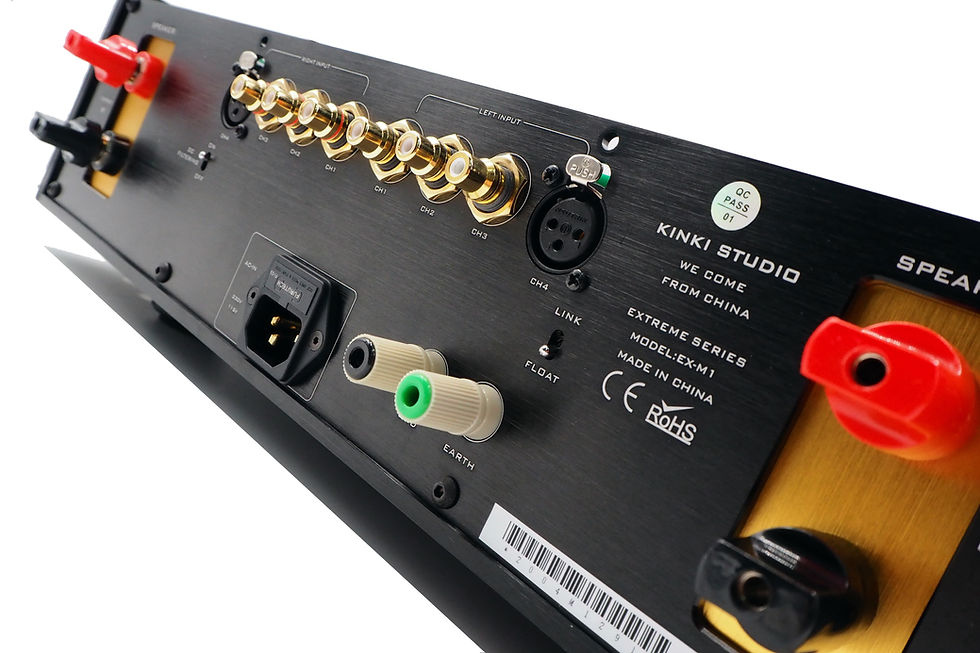
Credit: Michael Wright

Comments